
Explore the Most Authentic Hacienda in Yucatan, the Beautiful Sotuta de Peón
For a splendid outing at a hacienda near Merida, travel back in time to Sotuta de Peón, the most authentic hacienda in Yucatan. Sotuta de Peón is the only working hacienda in the world, which means it still produces the henequen fiber that once catapulted Yucatan to becoming one of the richest places in the world.
Instead of the usual brunch and done this past Father’s Day, I treated my husband to Sotuta de Peón’s Tour Henequenero, or Henequen Tour. In 3 hours, we explored the impeccably manicured grounds, roamed agave fields, witnessed the entire henequen manufacturing process, swam in a private cenote, and filled our hungry bellies with traditional, Yucatecan food.
Turns out that touring this authentic Yucatan hacienda was the perfect gift – my husband Steve absolutely loved it! And you will, too! A day exploring Sotuta de Peón is perfect for individual culture-seekers and families alike.
Ready to travel back to the glory days of Merida’s 20th century henequen boom? Journey with me through Sotuta de Peón, the most authentic hacienda in Yucatan!
TABLE OF CONTENTS
A brief history of Yucatan’s haciendas
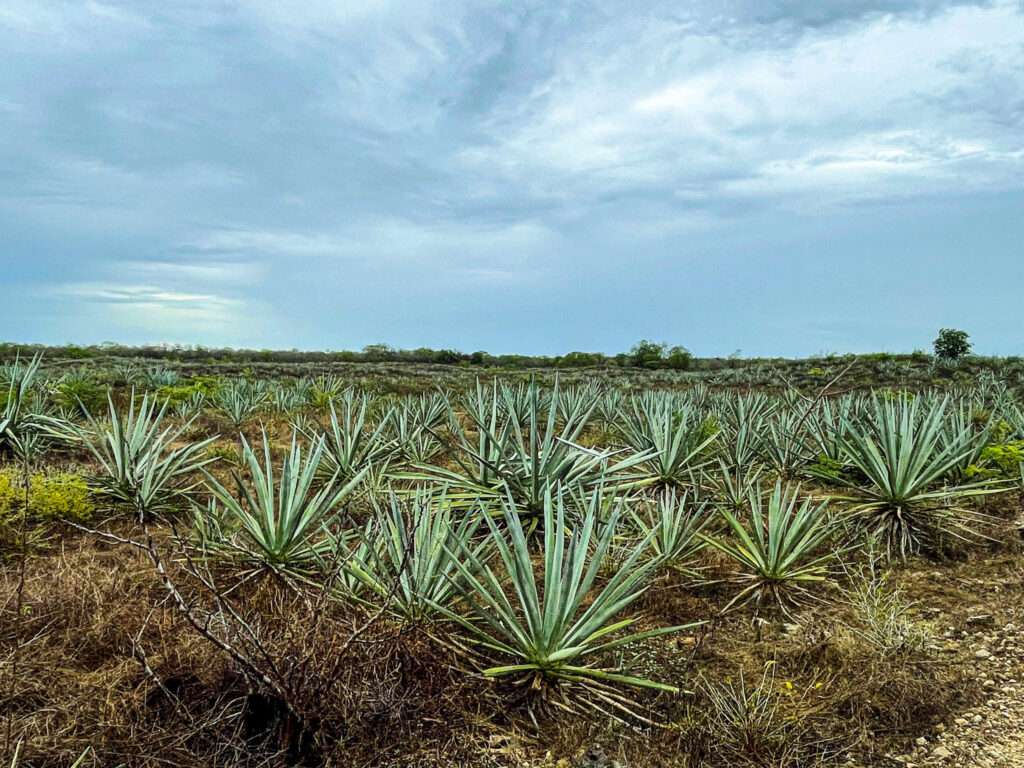
Merida’s haciendas were agricultural powerhouses for the cultivation of livestock and crops during the city’s colonial zenith. Between 1880 – 1916, these Yucatan haciendas became the world’s top producers of henequen, a fiber extracted from the agave plant. Haciendas fashioned henequen, also called sisal, into rope and other goods before exporting it all over the world.
The manufacture and export of henequen heaped astonishing wealth on the region. This is why you’ll often hear henequen lauded Yucatan’s “green gold,” as it transformed the state into one of the richest places on earth.
Eventually, the rising manufacture of synthetic rope crushed Yucatan’s thriving henequen industry. As a result, the once-magnificent haciendas near Merida fell into decades of disrepair. That is, until wealthy Mexican bankers and entrepreneurs resurrected these palatial estates in the 1990s. At this time, they refurbished many of Yucatan’s haciendas, repurposing them into sprawling event venues, and grand hotels.
What makes Sotuta de Peón the most authentic hacienda in Yucatan?
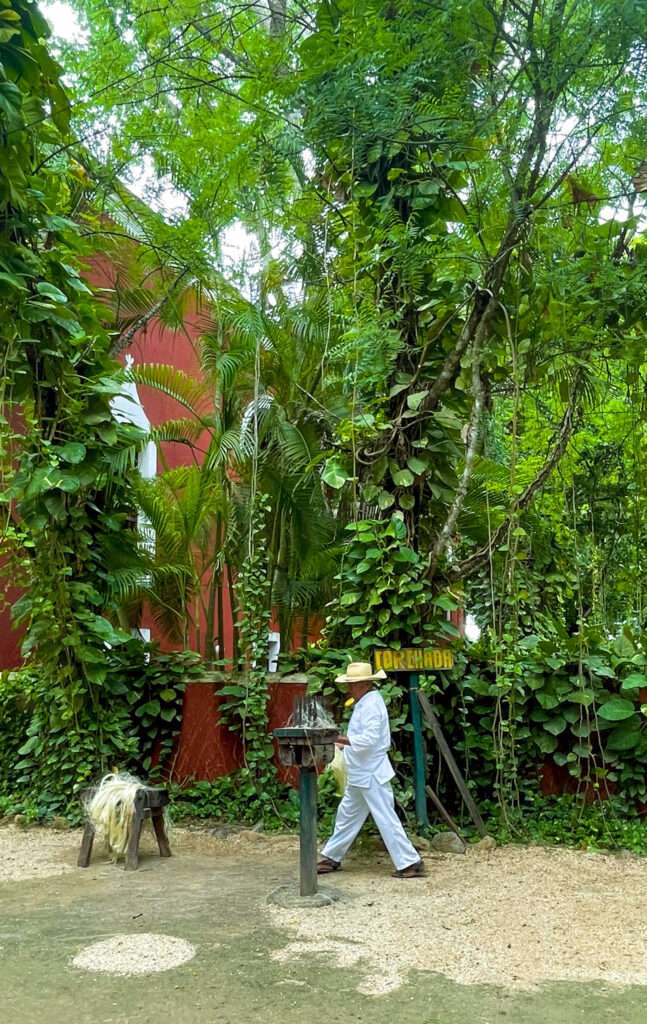
Nestled in the heart of rolling agave fields on the outskirts of Merida, Sotuta de Peón operated for 100 years after its founding in 1850. Like other Yucatan haciendas, it collapsed with the rise of synthetic fibers, laying dormant in the jungle near Merida until its restoration.
But Sotuta de Peón was more than restored to its former, aesthetic glory. The hulking machinery it used to process and manufacture henequen was resurrected, too. Along with reopening its doors as a luxury hotel, Sotuta de Peón also resumed producing henequen. This is the reason it stands as the most authentic hacienda in Yucatan.
In fact, today its full name is Sotuta de Peón Hacienda Viva. This literally means “living” hacienda, although the better translation is “working” hacienda.
How much henequen does Sotuta de Peón produce?
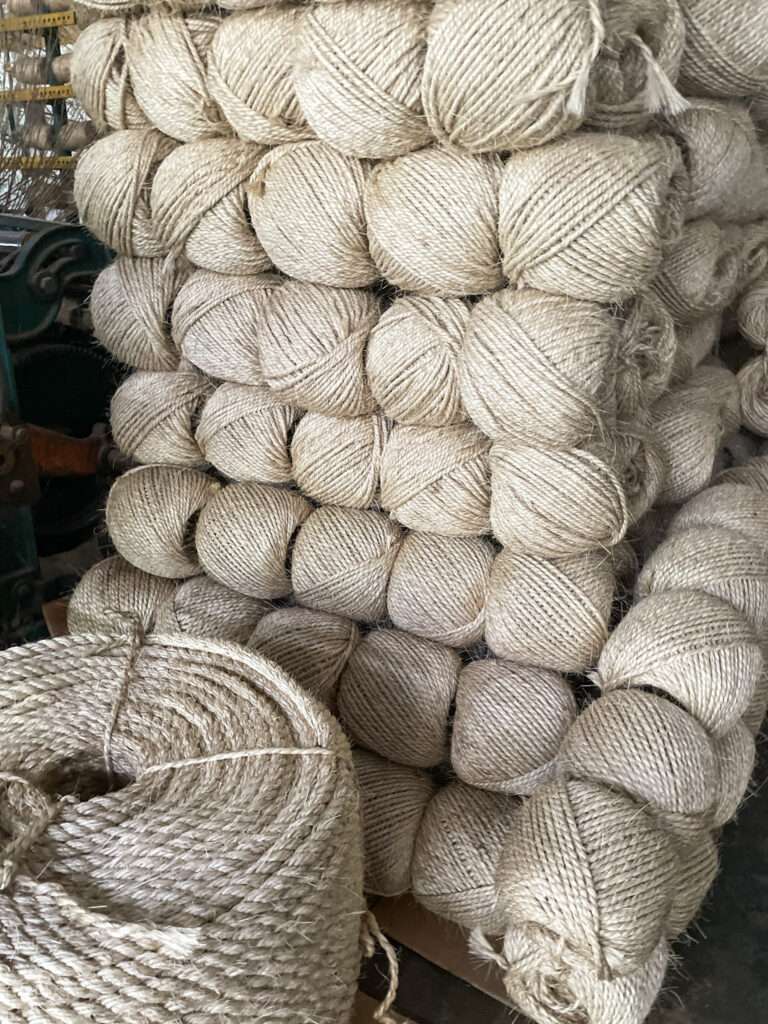
While Sotuta de Peón produces a steady amount of henequen for local purposes, it’s not nearly enough to compete with the mass production required for exporting rope around the world.
These days, henequen production at Sotuta de Peón serves to support the local population. During your tour, you’ll see the entire, henequen production process staffed by people from the local community. Many are descendants of the hacienda’s original Maya workers. Their labor provides a fascinating, behind-the-scenes glimpse of the laborious production of this once, highly-coveted commodity.
Our Walk Back Through Time
at Sotuta de Peón, the Most Authentic Hacienda in Yucatan
Arrival & Check-in
We arrive at Sotuta de Peón 5 minutes before the start of our 3-hour tour, which kicks off at 11 am. Check-in at the main desk goes smoothly and quickly, as had all my prior communication with the hacienda. (I booked the tour via WhatsApp messaging).
Originally, I had also purchased a day pass so we could spend some time poolside after the tour. But, as you’ll read below, an outburst of rain dashes our hopes for a fun-in-the-sun kind of day.
All this to share that the Sotuta de Peón was super accommodating when I requested to postpone our day pass for better weather. This, despite their purchase rules explicitly stating no changes or cancellations allowed. Thumbs up to the hacienda’s customer service for their flexibility and understanding!
Ivan & the Sacred Ceiba Tree
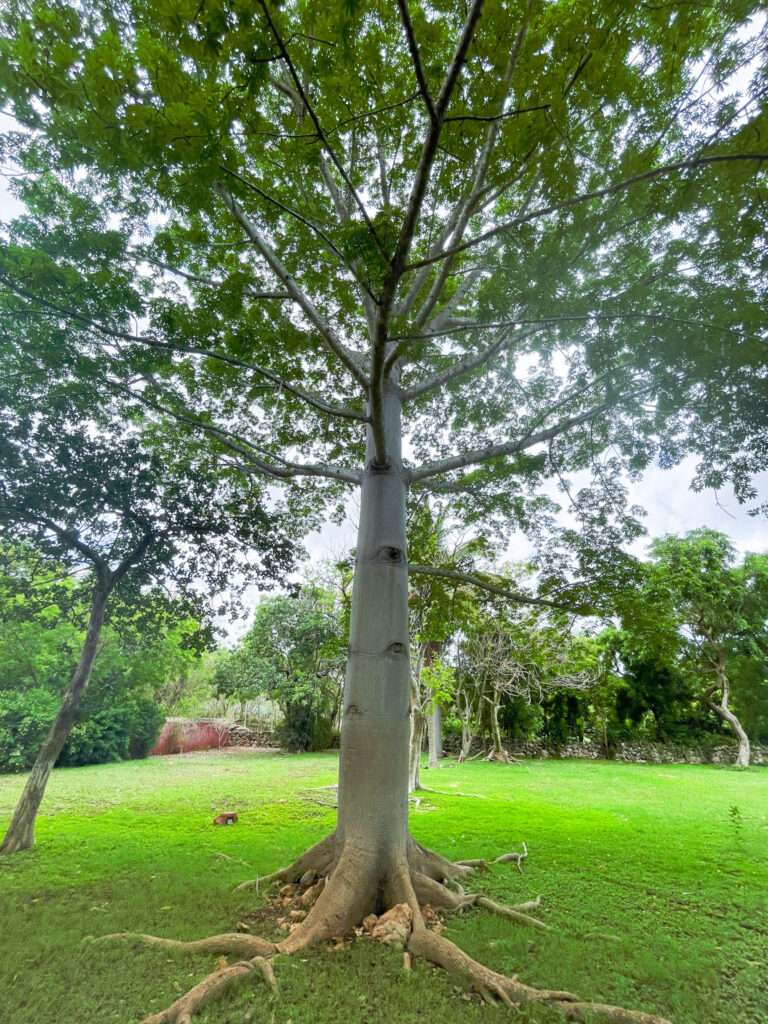
After waiting a few minutes under the shade of a palapa, our tour guide, Ivan, appears. He immediately launches into the history of Yucatan’s hacienda heyday in dramatic, captivating fashion. Our group of 8 is immediately hooked!
Let me tell you, as a former, private Rome and Vatican City tour guide, I’m picky about the tours I take, and judgy AF of tour guides. Ivan, however, gets my full-throttle endorsement. Talk about a master raconteur! He exudes charisma and hospitality, possesses extraordinary knowledge, and absolutely revels in bringing the past to life. A++!
We follow Ivan down a winding path that cuts through impeccably manicured grounds where peacocks and horses roamed freely. He brings us to stand in the shadow of a towering Ceiba tree, which you’ll notice all over Merida, and surrounding Yucatan. When Ceiba’s bloom, a white, cottony substance billows out that my local friends call Yucatecan snow.
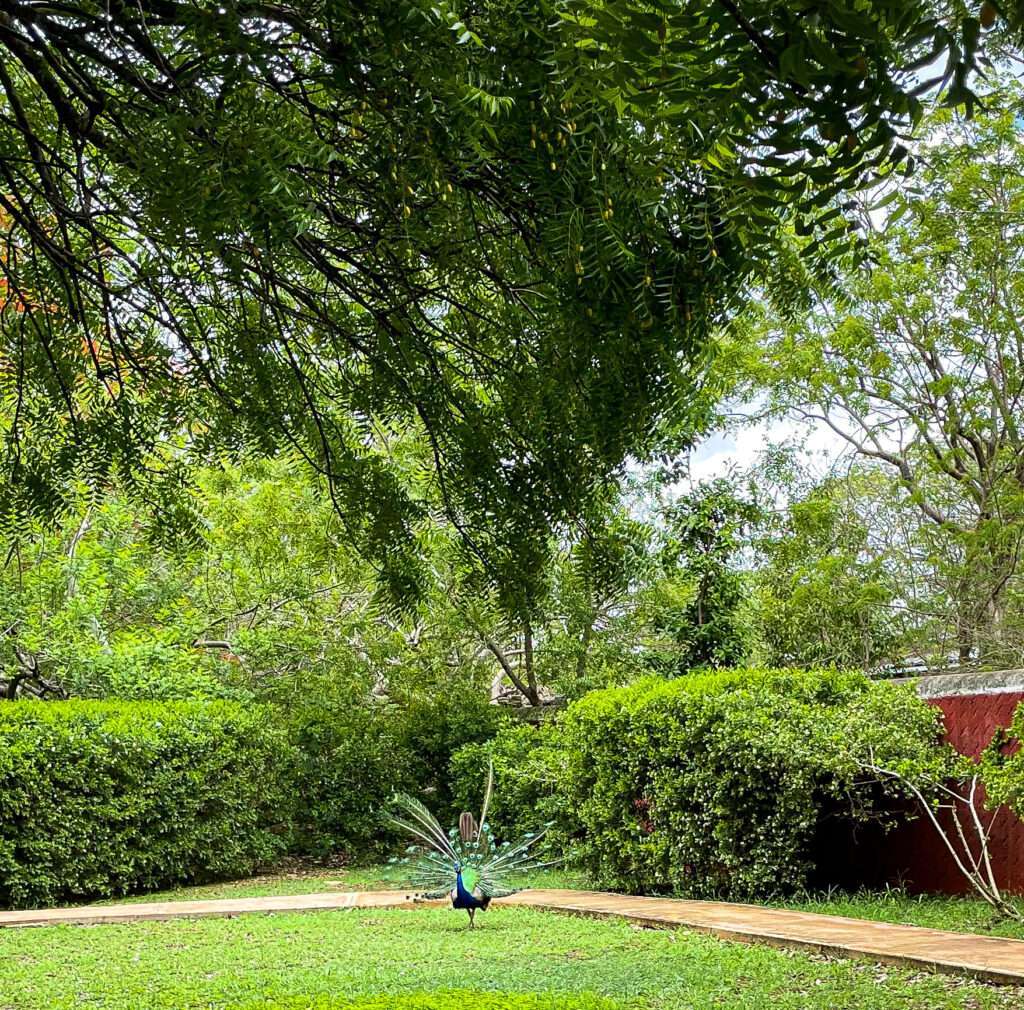
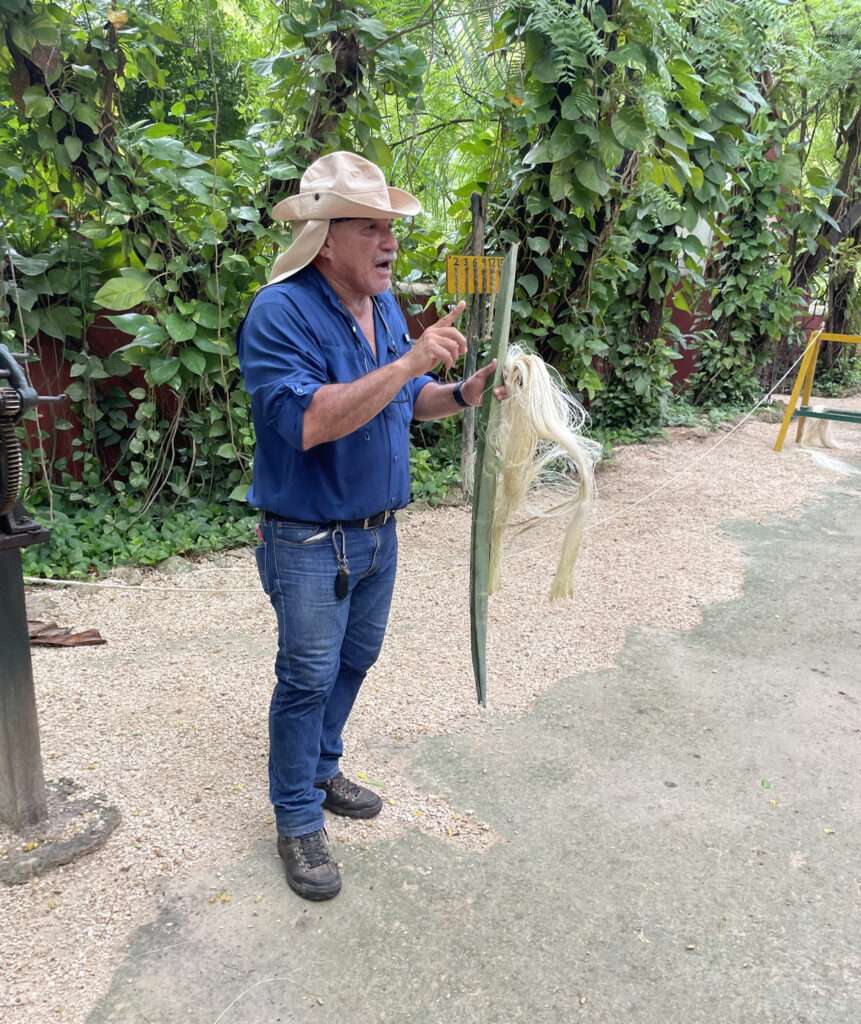
Ivan recounts that the ancient Maya believed the Ceiba tree to be sacred, telling us it inspired countless Mayan legends and religious ceremonies. To the Maya, the Ceiba was the “tree of life.” They believed its branches grew up to form the sky, and that its thickly-curled roots dug deep into the underworld. The Ceiba’s trunk, here on earth, was a divine conduit for communicating with the dead in both the upper and lower worlds.
Ivan encourages us to knock on the Ceiba’s massive trunk. It echoes back — the inside is totally hollow! No wonder the ancient Maya believed it delivered their otherworldly shout-outs!
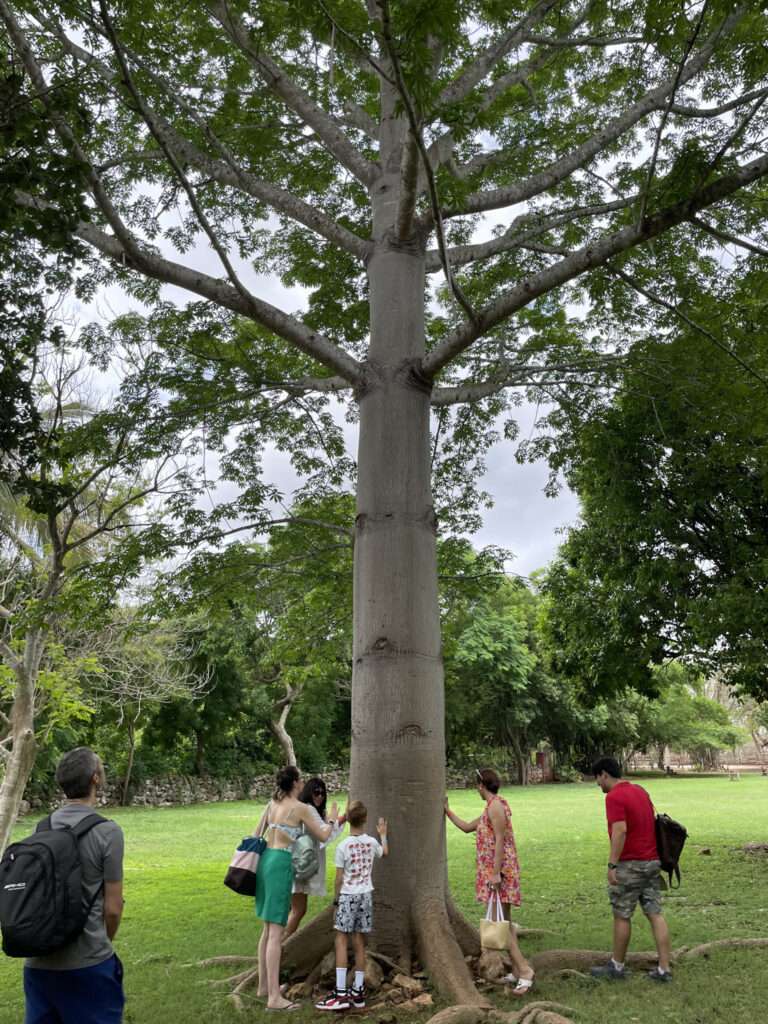
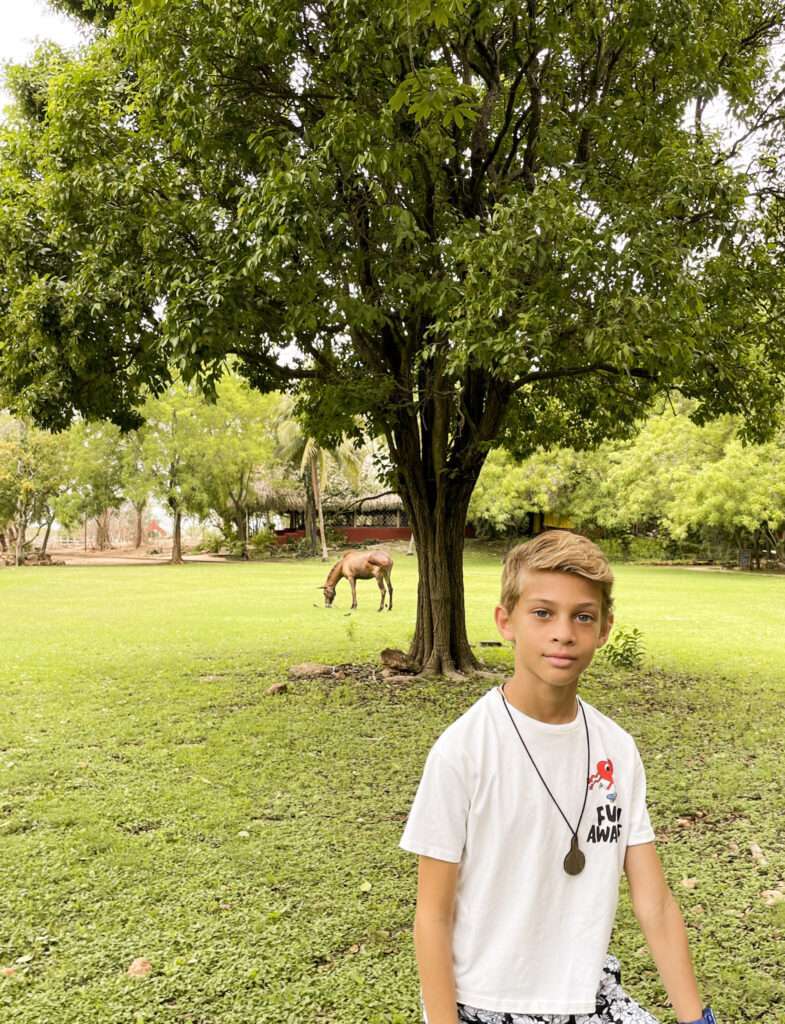
📌 Quick Tip — Opt for smaller tours (10 people or less) whenever you can. Smaller tours are almost guaranteed to provide a more intimate, rewarding experience. They do tend to be more expensive, but you’ll often receive more detailed information and personalized attention, as well as more time for your questions, and any special requests.
The Maya and the Main House
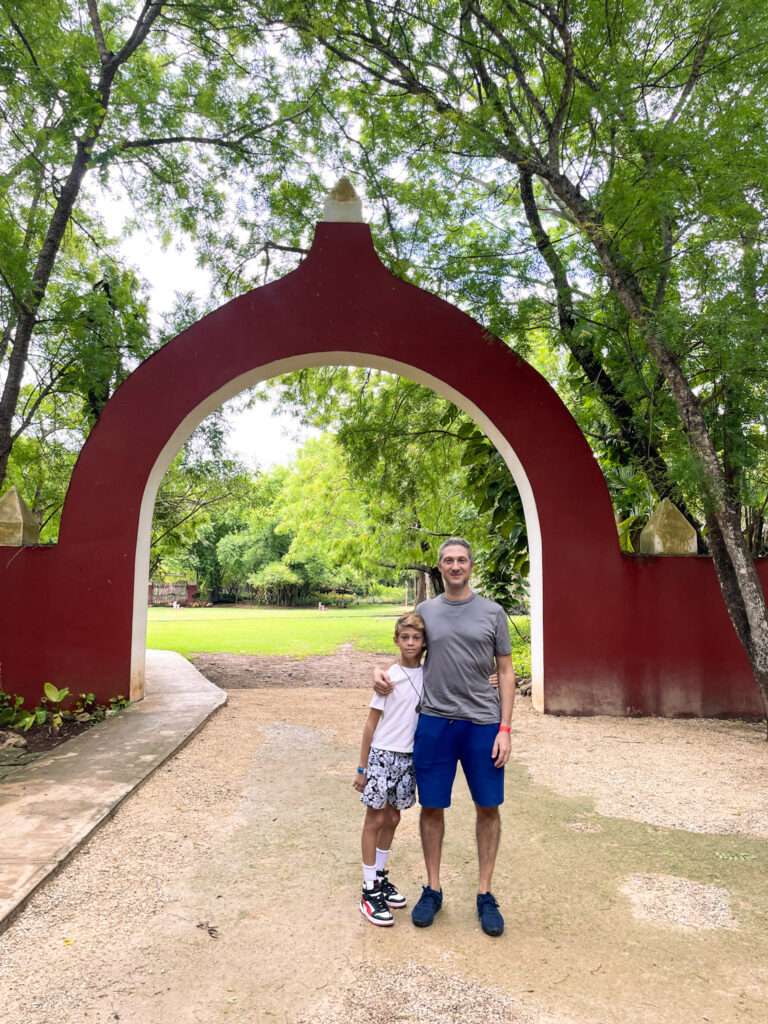
Next, we find ourselves beneath a great, crimson arch that’s adjacent to one of the hacienda’s original guest houses. It’s now a souvenir store, where you can shop all things henequen to your heart’s content. Anything you buy here goes to support the local workers, so I’d suggest taking home a set of coasters, or a tortilla basket or two.
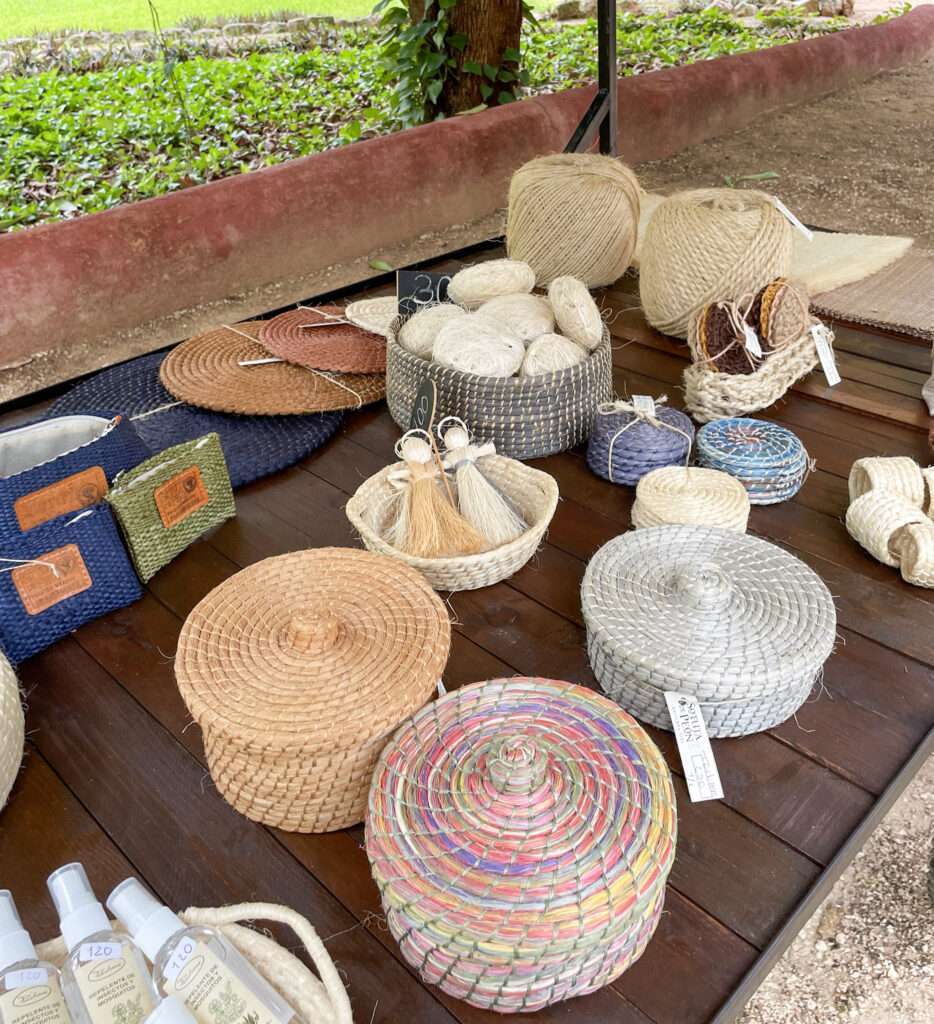
Ivan launches into the dark history of subjugation behind Yucatan’s henequen boom. He explains that wealthy European landowners built haciendas like Sotuta de Peón. Through various means, they coerced the local, impoverished Maya into indentured servitude.
The Maya had some civil rights, and they were “paid” for their labor. But pay wasn’t government-issued. Instead, haciendas issued tokens which could only be used to buy goods sold at the tiendas, or shops, on-site. This system created a cruel and false sense of financial autonomy, while inevitably keeping the Maya tethered to the haciendas.
At this point, an odd kind of shame washed over me. It’s uncomfortable, processing abuse while jaunting around the idyllic surroundings where said abuse went down. If any silver lining exists, it’s that Sotuta de Peón is now jointly owned by families living in Techoh, the surrounding municipality. They are the descendants of the original hacienda workers, and they receive a share of the hacienda’s current-day profits.
Our next stop is the homestead, or main house. It’s a wide, two-story building with rows of graceful arches on the top floor. Fatter arches support it on the first floor below. It’s not until now, about 45-minutes into the tour, that we step inside the main house and the whole “transported back in time” thing finally hits me.
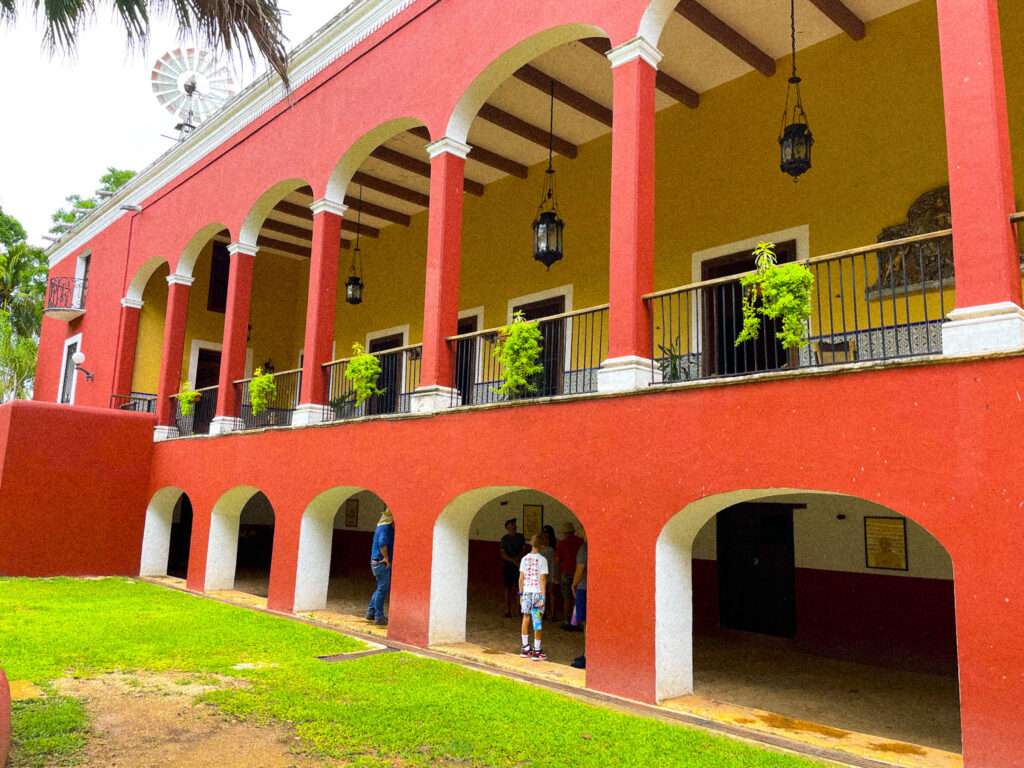
Yes, the hacienda is superbly remodeled. Nonetheless, everything appears bottled in time. Furniture, chandeliers, antiques, finishes, artwork – all of it – recapture the grandeur of the homestead during Yucatan’s “green gold” boom.
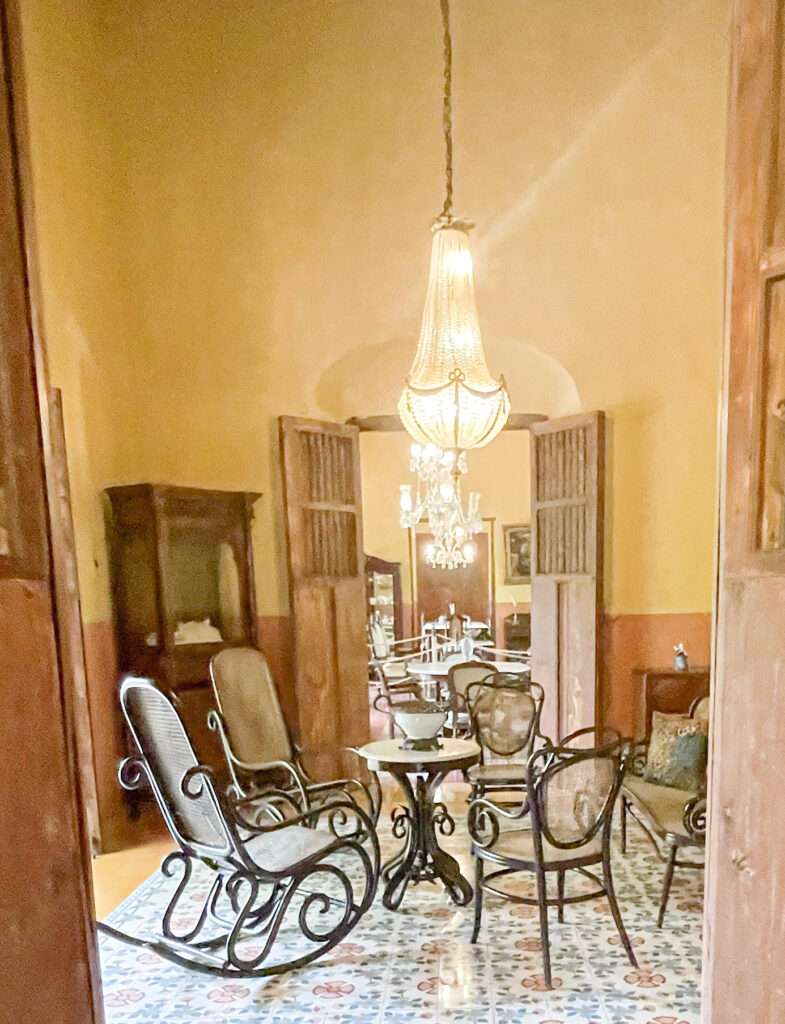
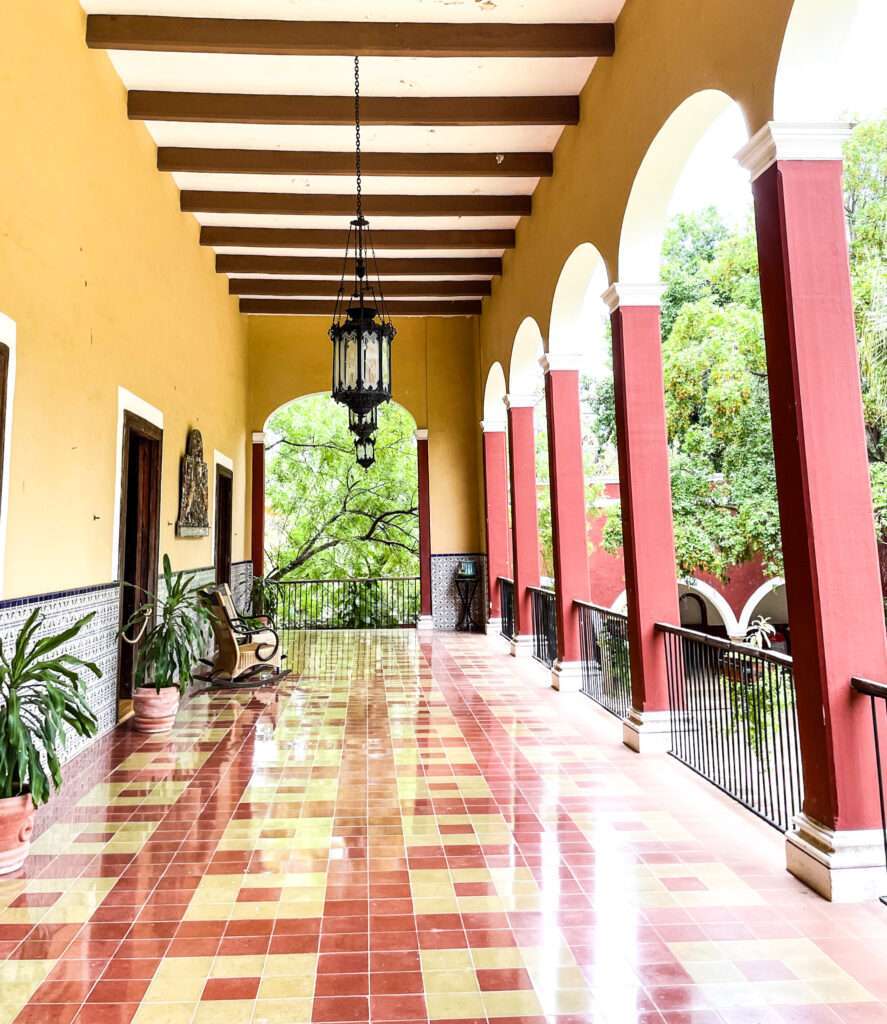
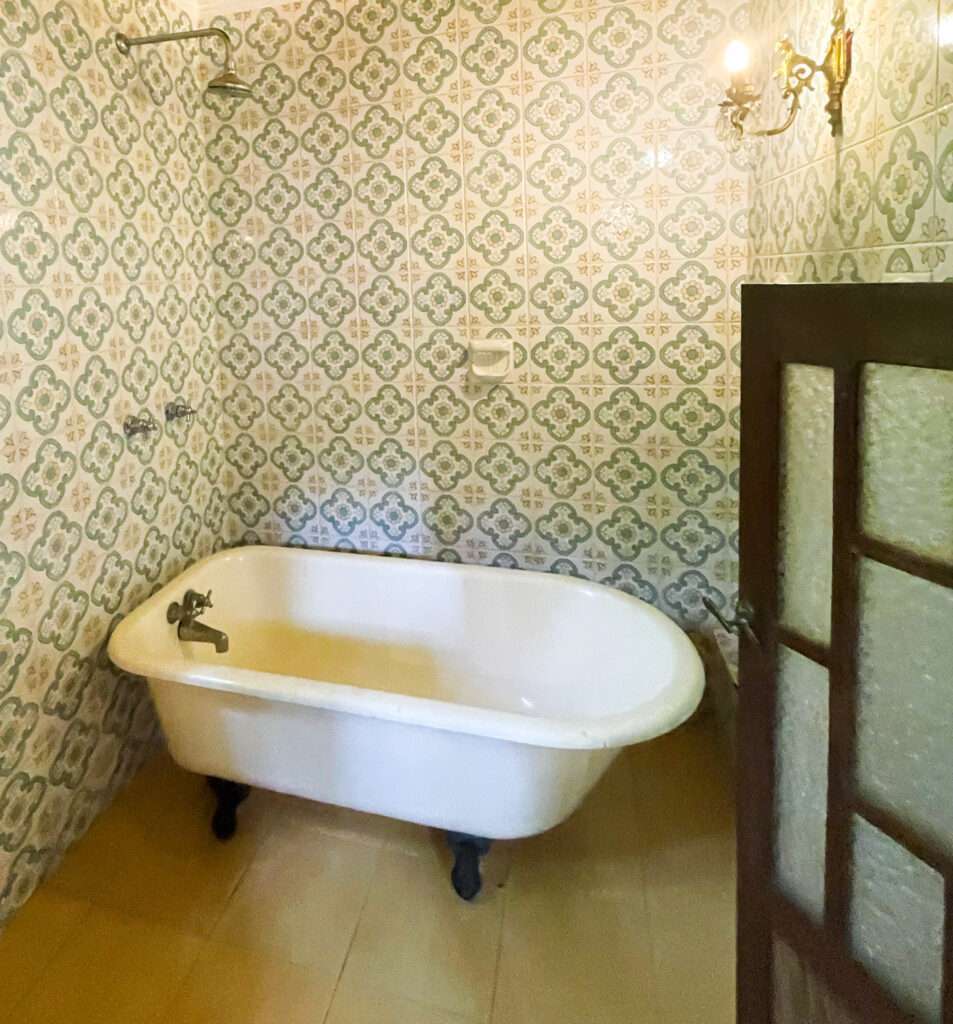
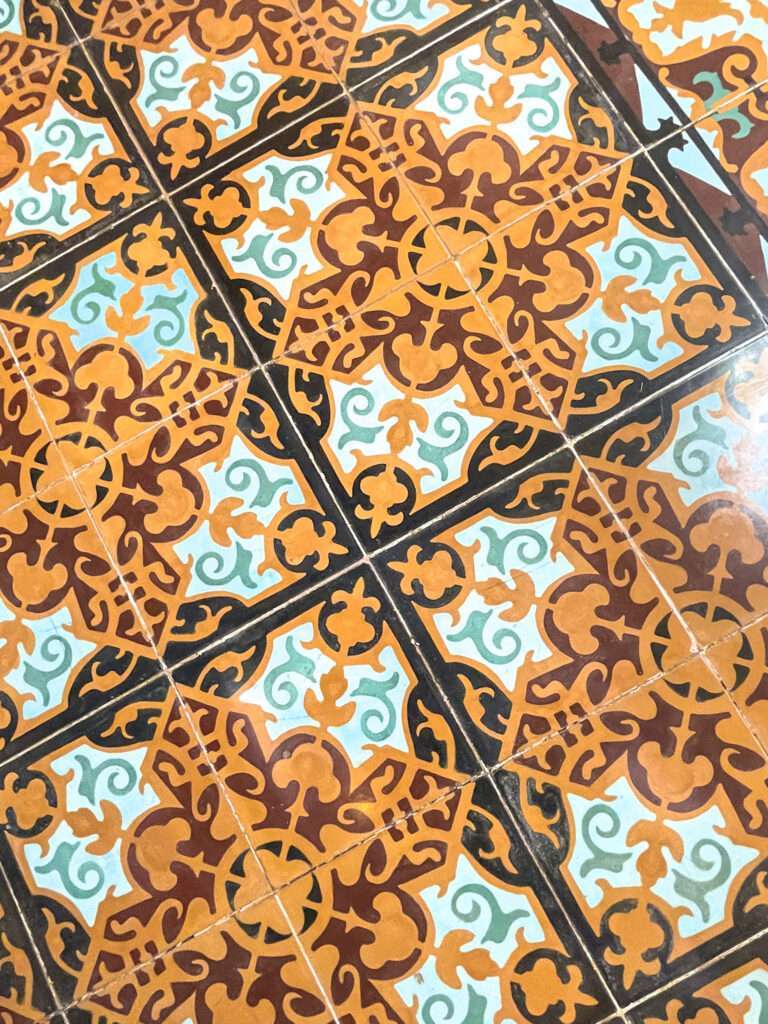
Ivan explains the meaning of the name Sotuta de Peón. The Peón family, pioneers of the henequen industry who arrived from Spain in the 18th century, built the hacienda that bears their name. “Sotuta” is a Mayan word meaning “swirling waters.” It’s possible this is a nod to the numerous cenotes scattered about the property.
The Henequen Factory at the Most Authentic Hacienda in Yucatan
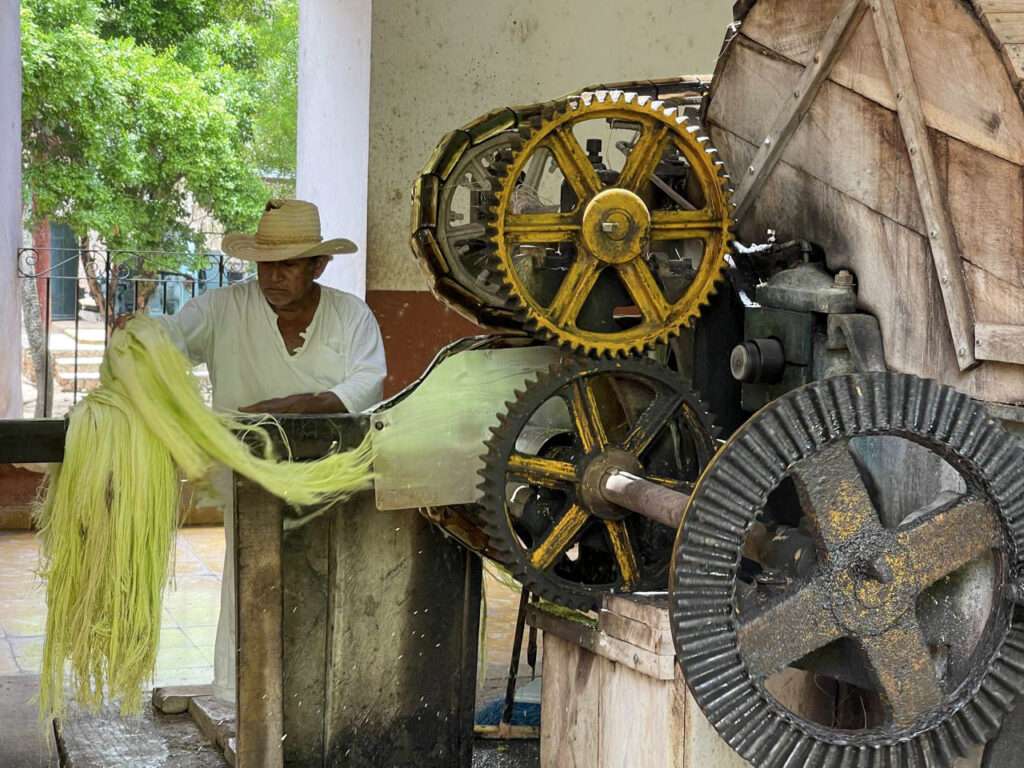
We next arrive at the spot that makes Sotuta de Peón the most authentic hacienda in Yucatan – its working henequen factory.
Have a look at the below video, which shows the extraction of henequen from the leaves of the agave plant. It’s grueling and thankless work done on a dangerous, ear-splittingly loud machine called a desfibradora de henequen. The largest and most important machine in the extraction process, its invention in 1855 revolutionized the henequen industry by speeding up the processing time. The increased speed enabled Yucatan’s entire industry to flourish.
After this, Ivan and one of the workers demo how rope is fashioned from dried henequen fibers. I can’t imagine how calloused this poor man’s hands must be!
We visit other buildings connected to henequen production. Some house machines that condense henequen into bales, some have apparatuses that transform it into twine. The buildings are manned by workers wearing 19th century fashions. Sandals, white pants and shirt, topped off by a henequen sombrero.
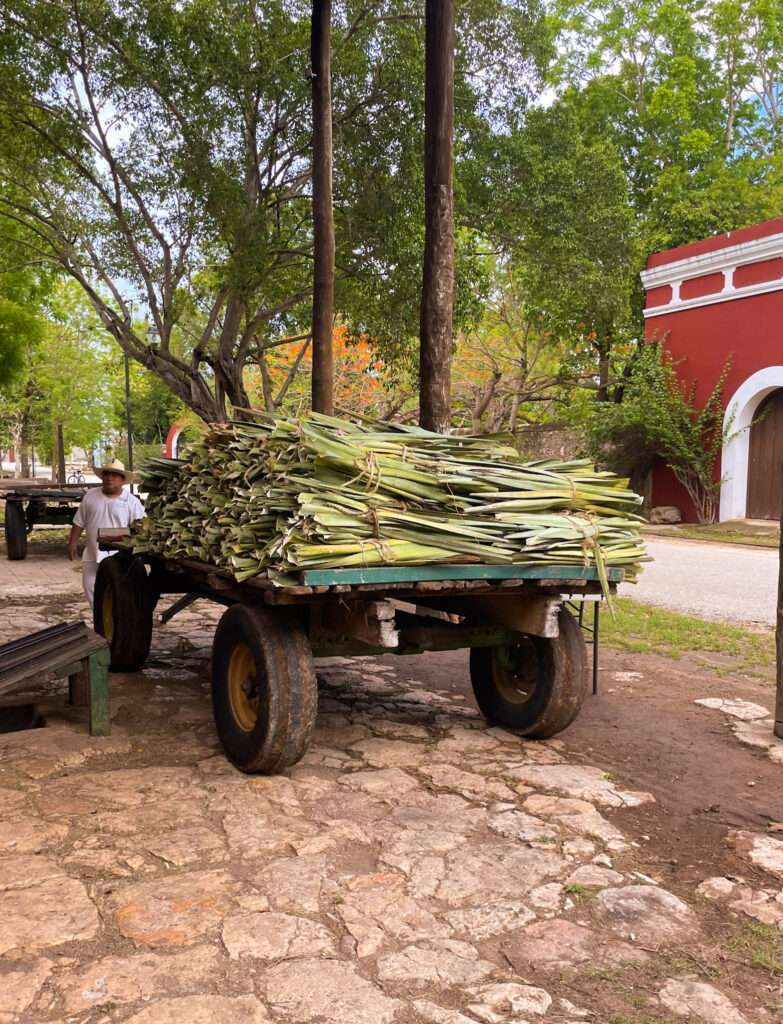
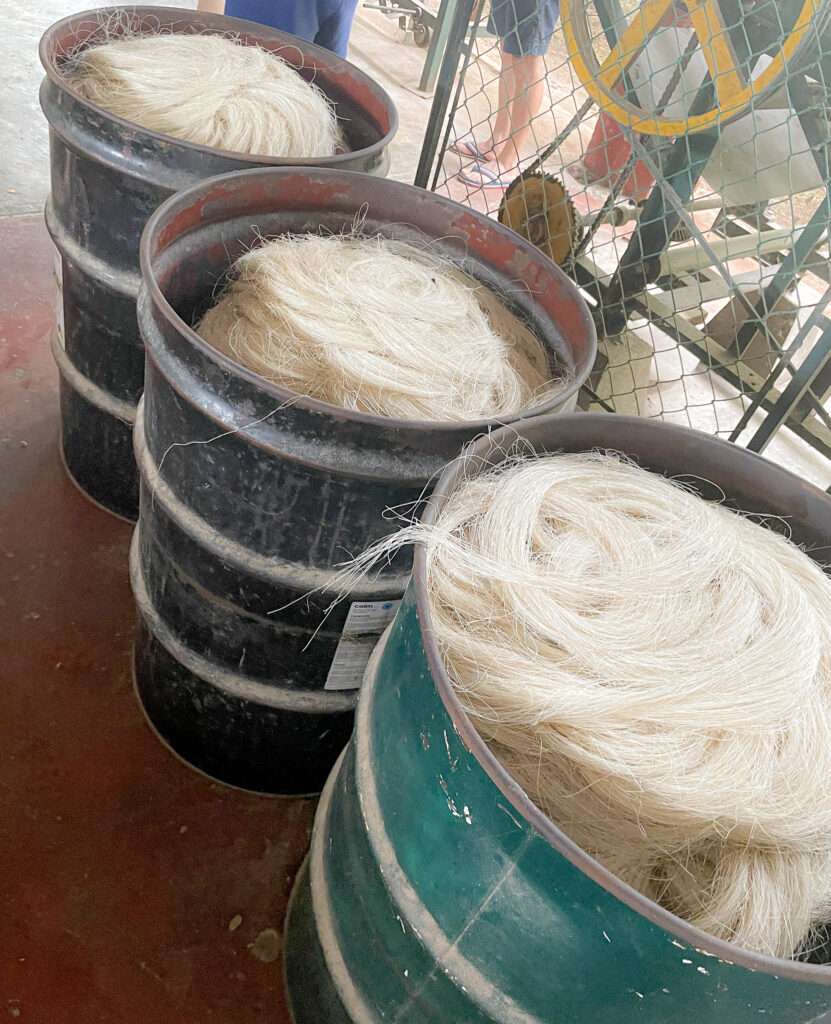
Just as the factory portion of the tour comes to a close, a 20-minute torrent of rain trapped us in one of the factory buildings. There’s really nothing to do but selfie it up with all that henequen!
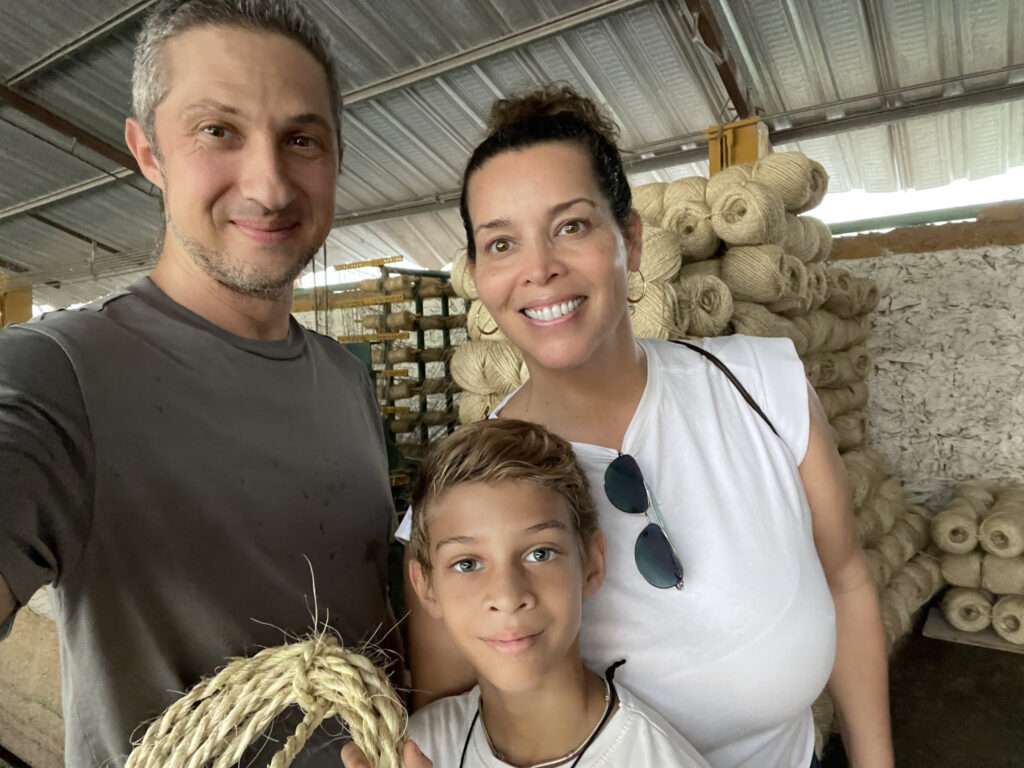
Once the rain passes, we make a muddy tromp to the hacienda’s restaurant, Kih, which means “henequen” in Maya. Inside, they give us large, plastic trash bags to protect our belongings from any more rain. This is super thoughtful since there’s more rain to follow!
A Subterranean Swim and Adieu
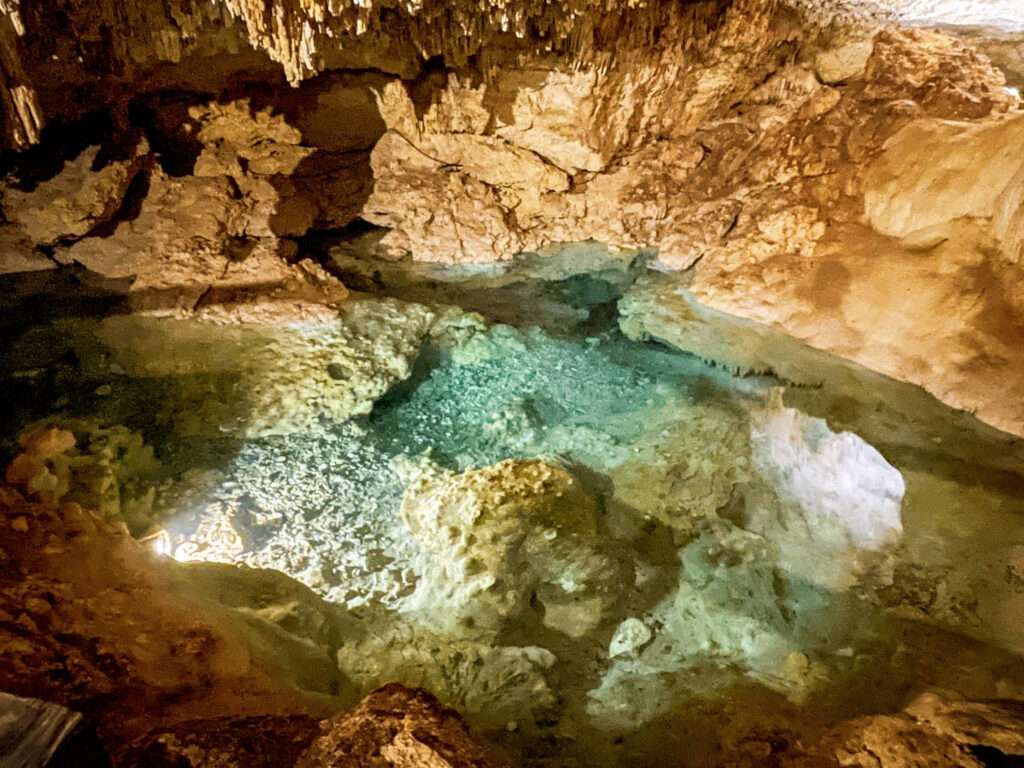
A horse drawn flatbed takes us from Kih through an endless series of agave fields to the cenote. As a compassionate animal lover diametrically opposed to such practices in the 21st century, I have some pretty incendiary thoughts on this. But, so as not to ruin this post, I’ll keep them to myself at the moment.
Now, back to our regularly scheduled programming…
We arrive at the cenote to find a masseuse and a fully-stocked bar cart and bartender perched at the entrance. What perks! If the threat of more rain wasn’t hovering, I’m sure someone in our group would have indulged. Yes, I’m talking about me.
Cenote Dzul-há means “water knight” in Mayan. It’s a cave-type cenote burrowed 65-feet underground. No amount of rain could spoil this magical part of the tour. Hallelujah!
Since there were just 8 of us, Dzul-há’s refreshing waters felt more like enjoying a private spa experience than a group tour. At its deepest, this natural wonder is 32-feet, which was perfect for snorkeling and spotting tiny fish. There’s also a relaxing, shallow area where you can sit and laze. The gentleman who mans the cenote jokingly called it a Mayan jacuzzi.
After a blissful hour in the cenote, we go up for quick showers, and to change (there are showers and a spic-and-span dressing room on-site). We hop back on the wagon, make our way back across the agave fields, and arrive back at Kih. Our excellent tour of the most authentic hacienda in Yucatan has come to its end.
A Secret Vegetarian Menu
We thank Ivan profusely for our incredible tour. Then we head into the restaurant where a traditional, Yucatecan snack awaits. (It’s included in the tour!). However, ssince Yucatecan food is very meat and pork heavy, I let the hacienda know ahead of time that our family is vegetarian.
I’m impressed to find we each have a plate of vegetarian empanadas waiting on the table. However, they weren’t as ample as the meat-based plates our fellow tour members were eating, so we asked what other veggie dishes they had. Much to our surprise, our server whipped out a secret vegetarian menu! If you’re plant-based, ask for the veggie menu when you visit!
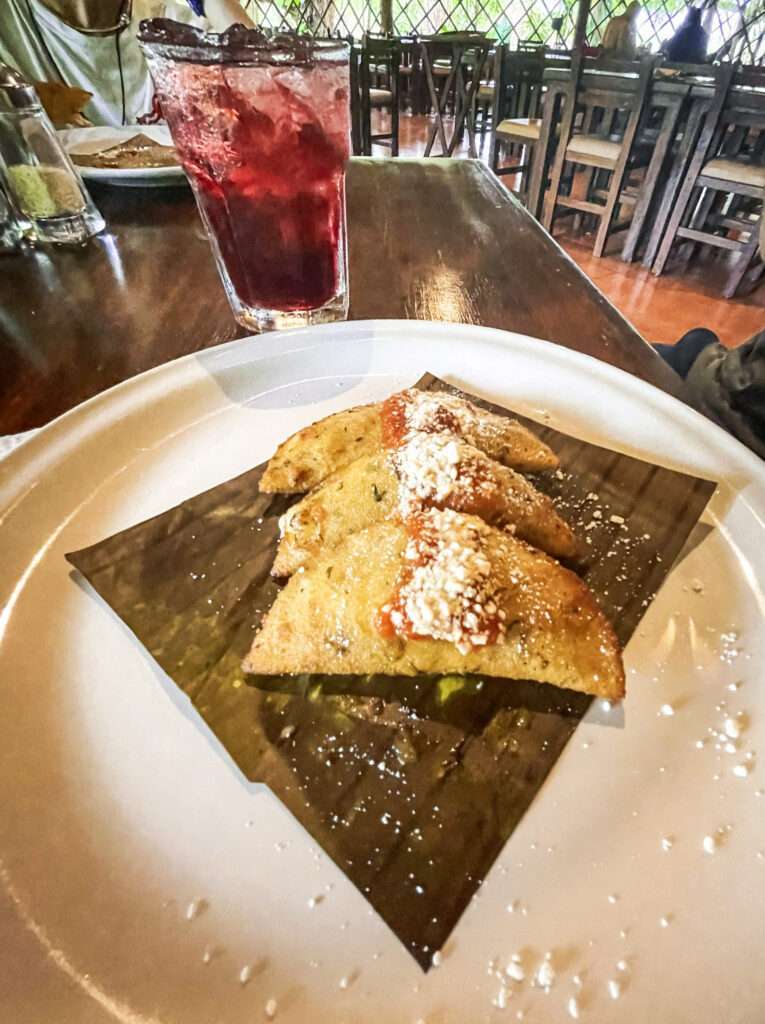
Visiting Sotuta de Peón FAQ
How much does the Henequen Tour cost? What’s included?
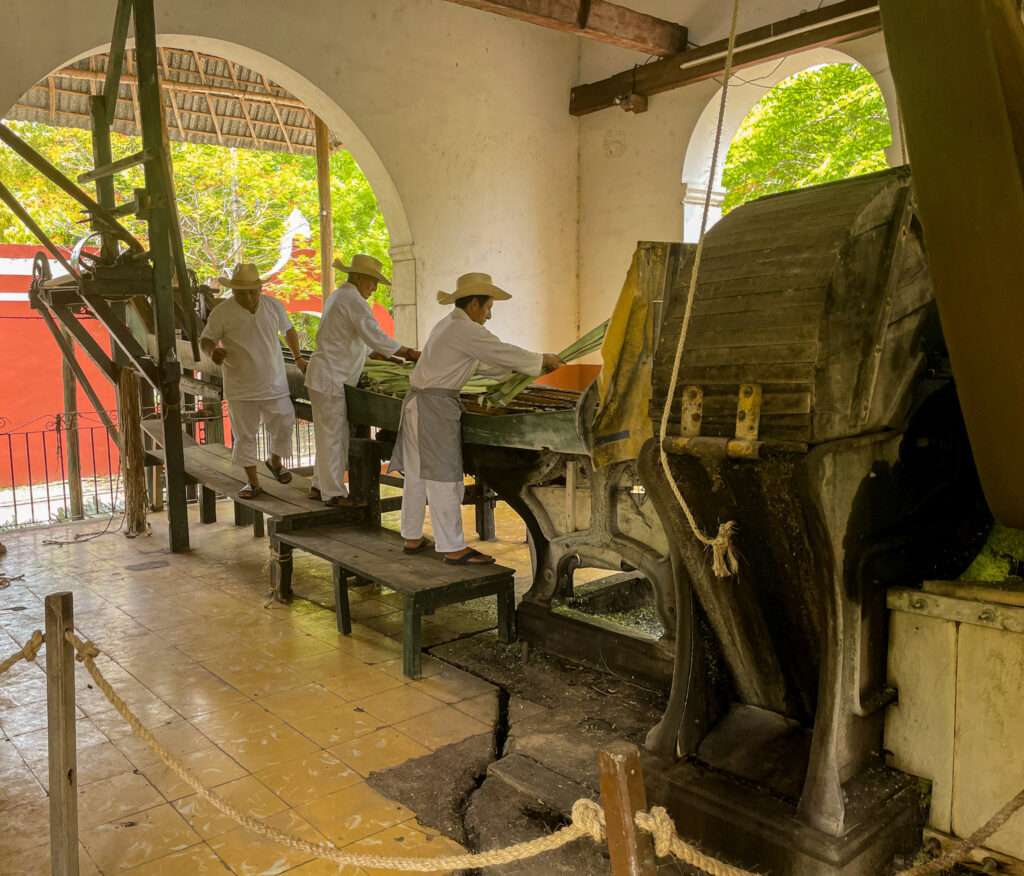
💫 GROUP Henequen Tour: $875 MXN for adults | $550 MXN for children from 4 – 12.
💫 PRIVATE Henequen Tour: $1,275 MXN per person. It requires a minimum of 6 people.
💫 The Henequen Tour includes: 2 hours touring the hacienda and factory | 1 hour in the cenote | traditional Yucatecan snack | refreshments.
💫 Group tours run from Monday to Sunday, 3 times a day starting at 9 am, 11 am and 1 pm.
💫 For private tours, you can schedule at whatever day and time you like.
💫 Tours are in Spanish, English and French. I don’t know if Ivan is the only guide, but if so, his English and French are solid (my husband is French and conversed with Ivan extensively).
💫 BONUS: If you book a day pass for the pool, like we did, or combine your visit with other tours or activities (see below), you’ll receive a 15% discount.
How do I get to the most authentic hacienda in Yucatan?
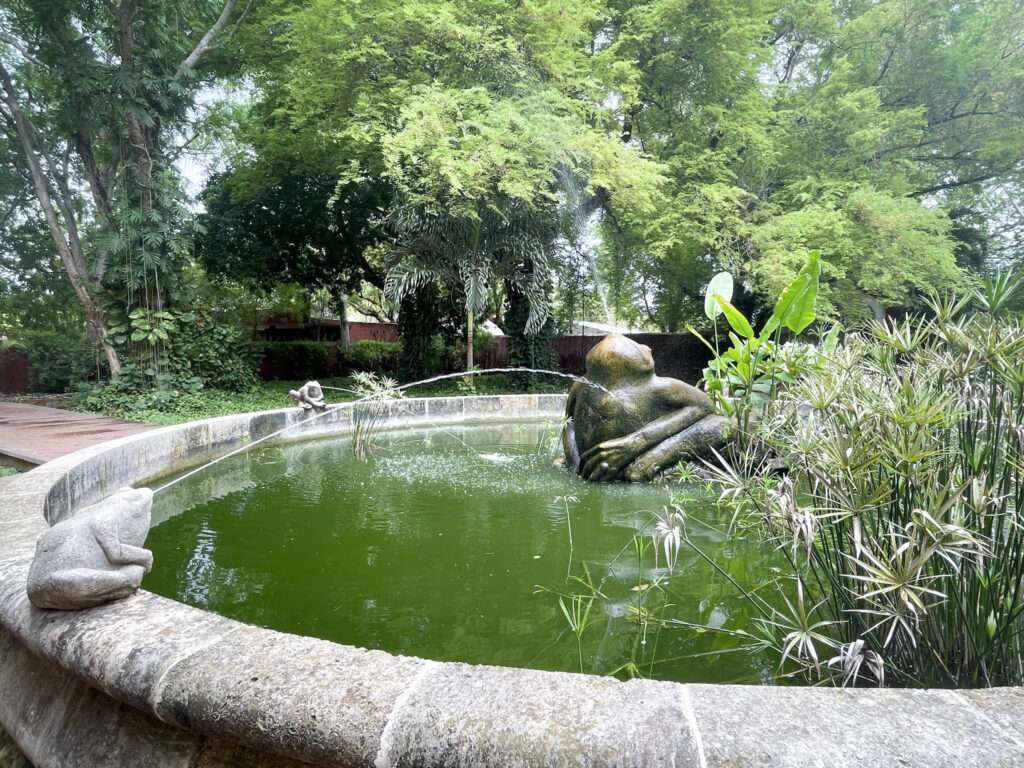
You’ll need a car to reach Hacienda Sotuta de Peón. While the hacienda is near Merida, it’s about 40 or so minutes from downtown. So it’s a bit off the beaten path, and there aren’t any direct bus routes.
Alternatively, it’s possible to take Didi or Uber. But I’d be weary of finding one to pick you up when your excursion is over. The hacienda is located in a small municipality where ride shares are scarce. But you can always call ahead to check if the hotel can help you arrange this.
What should I bring on the tour?
💧 Refillable water bottle
🧢 Sun hat or cap
👟 Comfy walking shoes
🩱 Swimsuit
🧖♀️ Towel
🥿 Water shoes
💰 Cash to tip your guide and purchase souvenirs, massages, additional food, etc.
☀️ Sunscreen. Make sure it’s reef safe since you’ll be going in cenote.
Should I tip my tour guide? How much?
Yes, you should tip your tour guide. As a former guide, I know they’re generally paid a fraction of what you’ve paid for the tour. My split as a guide in Italy was very generous, but I’m not sure how much a private guide makes in Mexico. But, as a rule of thumb, let’s just say the house always wins.
In Mexico, we’ve fallen into the groove of tipping 15% for most service-related things. 10% is sufficient, and implies room for improvement. 20% is for an excellent job well-done.
What else is there to do at Sotuta de Peón?
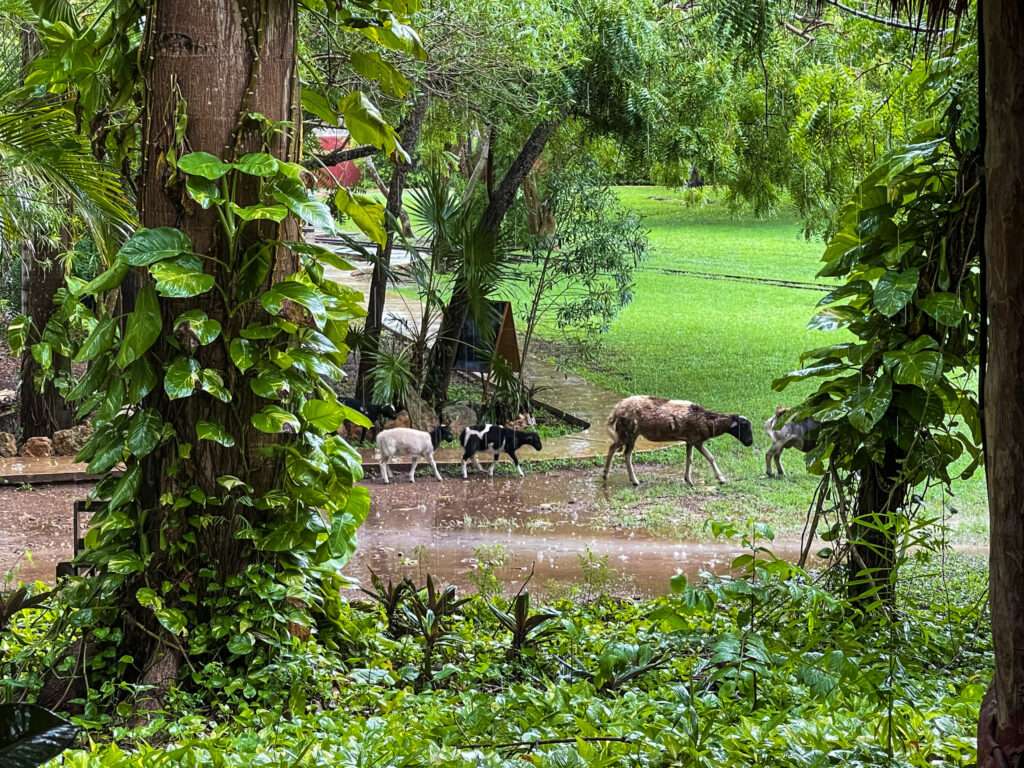
There is sooooo much to do at Sotuta de Peón. Seriously, while you’re out here I’d take the opportunity to combine the tour with other activities like:
🏊♀️ A poolside day pass
🐎 Horseback riding
💆♀️ Visit the spa
🐑 Visit the petting zoo
🌅 A sunset tour that includes a 4-course meal
📷 A private photo session
🔥 A temazcal session
🏍 An ATV ride through the agave fields (you can even do this at night!).
🍽 Dining experiences.
🌙 Stay overnight in one of the hacienda’s beautiful villas
Remember that the hacienda is jointly-owned by descendants of those who used to run it. And the people currently working there are also descendants of these workers. So when you purchase goods & services at Sotuta de Peón, you’re not only supporting the local community, but also the legacy of its original workers.
When is the best time to visit Sotuta de Peón?
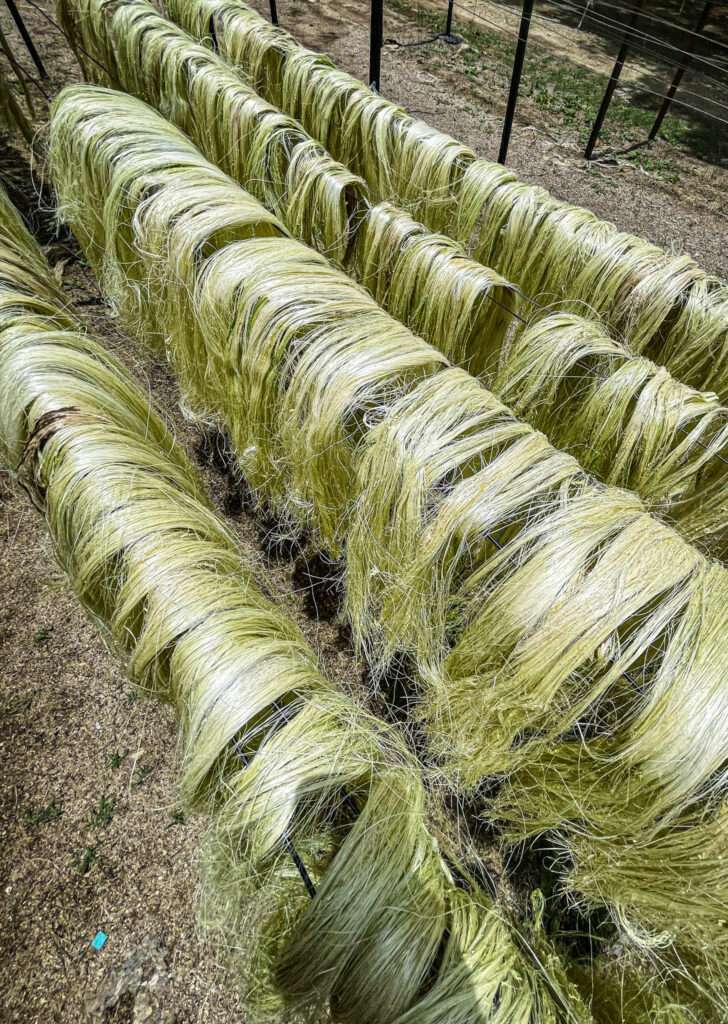
Not in June, at the start of rainy hurricane season, like me! Lol.
Seriously, the best time to visit any haciendas near Merida, or do anything outdoorsy, is always going to be December through April, when the weather is drier and less humid.
Will kids enjoy a tour of an authentic Yucatan hacienda?
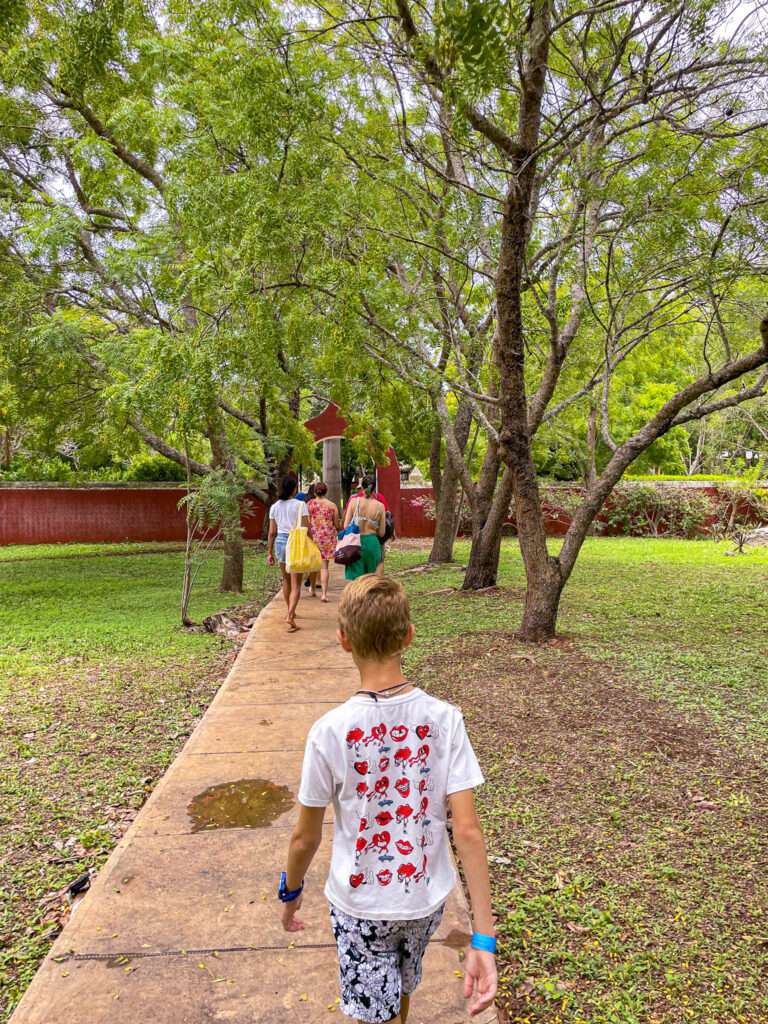
Absolutely! All of the henequen machinery and vibrant storytelling fascinated my 8-year-old, and of course he loved the cenote. There’s also tons of green space to run around, roaming animals and a petting zoo, which all kids will dig. Sotuta de Peón makes a great family day out.
What else is there to do in the area?
If you’ve got time on your hands after visiting Sotuta de Peón, Hacienda Mucuyche is another hacienda near Merida that’s in the area. While I wouldn’t call it one of the most authentic haciendas in Yucatan (the henequen factory is still partially in ruins, and much of the site is newly-built), Mucuyche offers a solid tour followed by a dazzling swim through two different cenotes.
Are there other authentic haciendas in Yucatan to visit?
Yes, of course. But Sotuta de Peón is hands down the most authentic hacienda in Yucatan.
The Wrap
If you’re looking to visit a hacienda near Merida, speed dial Sotuta de Peón to the top of your list! It is by far the most authentic hacienda in Yucatan, which makes a visit one of the highlights of your trip!
The henequen factory tour is an excellent opportunity to learn how the world worked before mass production. It also provides a wonderful context to understanding the reach of Yucatan’s former wealth and global power.
Even if you don’t opt to take the henequen tour, there is still so much to do at Sotuta de Peón that you’re certain find something to please your palate.
To discover more ideas about things to do at other haciendas near Merida, check out my article, Beat the Heat With a Poolside Day Pass at These 6 Merida Luxury Haciendas.
I’m always happy to help you with any questions, too. Just give a shout to me in the comments below!
As always, inspired travels Amigas! 💜
FYI – The World I Roam contains affiliate links. When you make purchases through these links, you support this site at no additional cost to you. Thanks for the love! ❤️


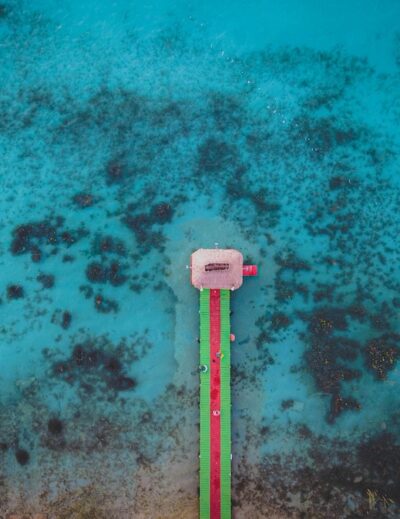

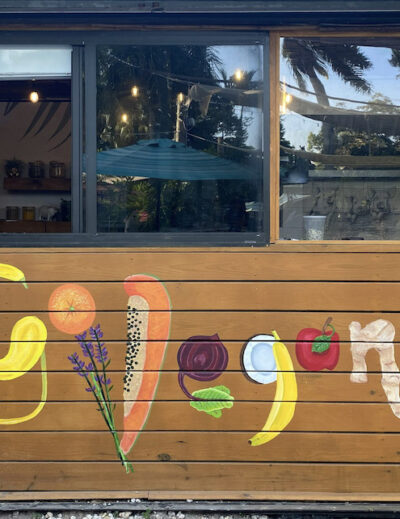
Leave a Reply